Vertical Fall Arrest Systems
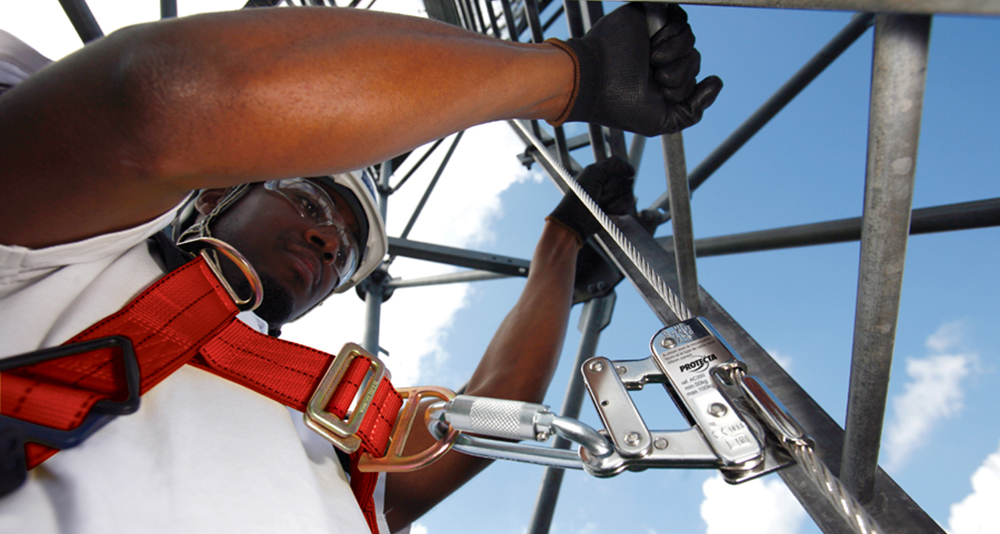
Vertical fall arrest systems (VFAS) are formally referred to as “Guided Type Fall Arresters Including a Rigid Anchor Line”. They comprise a device, often called a “shuttle”, “slider” or “trolley” but formally a “Guided Type Fall Arrester”, which can move up and down on an anchor line and will automatically lock in position on the anchor line in the event of a fall.
These systems are usually permanently installed onto fixed ladders or may be an integral part of a ladder system. They are intended to provide an automatic means of fall protection whilst ascending or descending a ladder.
There are 3 main types of Vertical Fall Arrest System available:
- Integrated Rail – where a fixed ladder and a fall arrest system are manufactured as integral parts of the same system
- Retro-Fit Rail – where the fall arrest system is a rigid rail which is permanently mounted on to a fixed ladder
- Retro-Fit Cable – where the fall arrest system is steel cable which is permanently mounted on to a fixed ladder
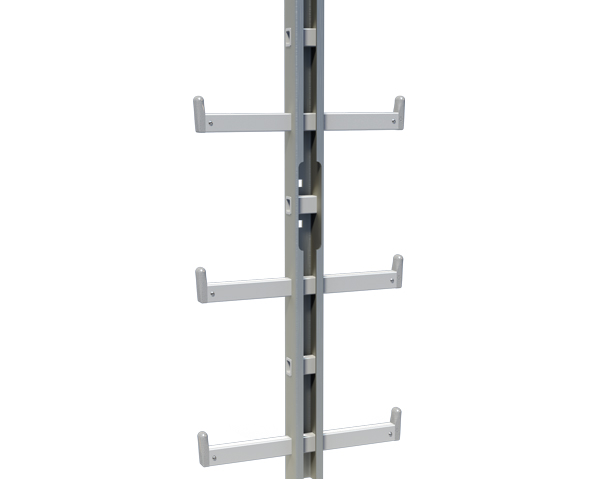
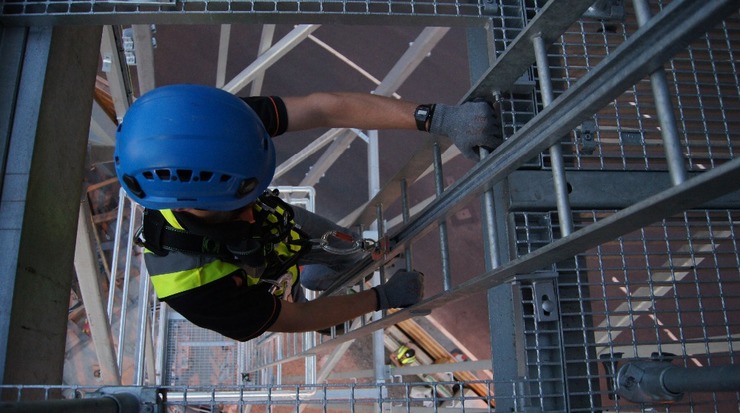
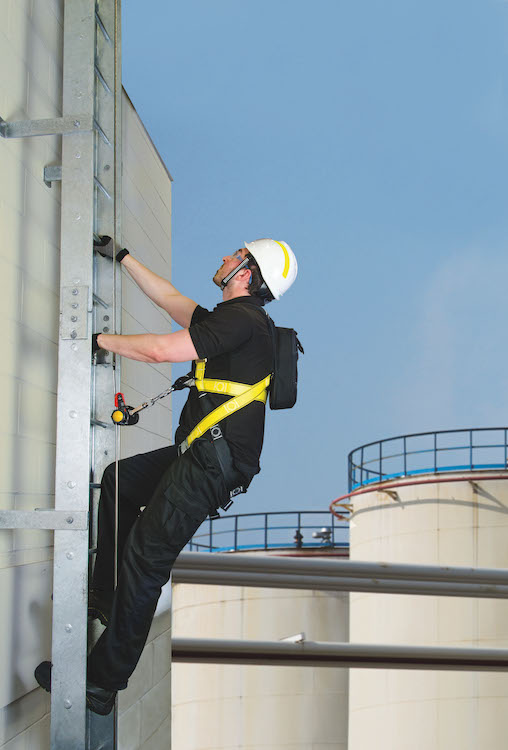
There is sometimes confusion over the use of the term ‘Rigid’, but this means that the system is fixed at both the top and bottom, such that it is held in position. There are other types of vertical fall arrest system, referred to as “Guided Type Fall Arresters Including a Flexible Anchor Line”, which usually comprise a fibre rope fixed to ladder only at the top. These flexible line systems are usually installed on a temporary basis. They are also often used horizontally, with horizontal flexible line systems, but this should only be done where the system has been subject to testing specifically for this use which is beyond the scope of the standard.
Standards & Guidance
The design and testing of vertical fall arrest systems is covered in:
BS EN 353-1:2014+A1:2017 – Personal fall protection equipment – Guided type fall arresters including an anchor line – Part 1: Guided type fall arresters including a rigid anchor line
Levels of Safety
Vertical fall arrest systems are often considered as an alternative to cages on ladders and a comparison of these two options is given here:
- Fall Arrest Effectiveness – VFASs when correctly designed, installed and operated should have an insignificant probability of failing to arrest a fall, whereas cages on ladders fail to prevent or arrest a very significant proportion of falls.
- Use Limitations – VFASs should only be operated by persons who are suitably competent in their use and who have all of the appropriate PFPE required, whereas a cage on a ladder requires no specific competency or equipment for its use.
- User Support – VFASs, particularly rail-based systems, can provide a means of support to the climber allowing them to rest their arms during a long climb. It is also possible to rest against a ladder cage, but this is precarious and not recommended.
- Entry / Exit at Top – VFASs require careful design at the top to ensure the climber is in a safe location when attaching/ detaching from the system, whereas no such issues arise with caged ladders.
In summary, for short climbs (such as one storey), where a worker does not require a fall protection harness for any other part of his work, a caged ladder may be preferable to a VFAS. However, for longer climbs, or where the worker is wearing a harness for use elsewhere, then a VFAS may be preferable. Note that a staircase would always be preferable to any ladder for access from one level to another.
For existing ladders where it is proposed to install a VFAS a number of issues should be considered:
- A VFAS should not be used in combination with a cage on a ladder. HSE research showed that the cage could slow the fall sufficiently to make the arrest mechanism ineffective.
- A further issue is the complexities of rescuing someone who has fallen on a VFAS inside a cage. The rescuer usually has to climb past the casualty to install the rescue system above them and it will be difficult to do this inside a cage.
- The removal of a cage from a ladder should only be undertaken where a risk assessment for the work shows that the level of risk from continuing to use the ladder with the cage is greater than the risks involved in removing the cage.
Design Considerations
When a fall is arrested on a VFAS high forces can be generated within the system and these forces must be resisted by the system, its fixings and the substrate. The main elements to assess will depend on the type of VFAS:
- Integrated Rail
- Load is distributed across several mounting brackets and into substrate
- Retro-Fit Rail
- Load is distributed across several clamp brackets onto rungs or stile of ladder
- Load is then distributed across several ladder support brackets and into substrate
- Retro-Fit Cable
- Load is primarily applied to top anchor of system
- Where the top anchor assembly is mounted on the ladder, all load will be transferred into top rungs of ladder and through ladder support brackets to substrate
- Where the top anchor assembly is mounted directly on the substrate then only this element will need to resist fall arrest loads
Access and egress at the top of the VFAS is a very important element of the design, as this operation can be complex and require the use both of the climber’s hands. A well designed system-top will ensure that the climber can remain attached to the VFAS until they are standing on the upper platform and are protected against falls by some other means, such as a gate, before they detach from the VFAS. However, a poorly designed system will require the climber to try and detach from the system, whilst still on the ladder very close to the top. Attempting to detach from a VFAS at the top of a ladder, with no other means of fall protection is probably one of the highest risk activities a worker would undertake and would only come about through poor design. Unfortunately this has been a common design failing for many years.
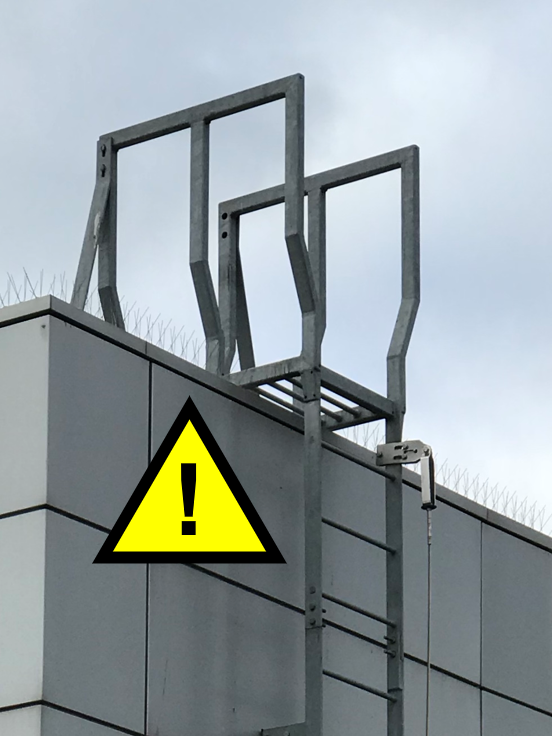
User Considerations
Users of VFASs should be adequately competent to use them safely. When these systems have been well designed and installed, they are not complex to use, but all users should have training in their use and demonstrate adequate skills and experience in their operation, or work under supervision while they develop these skills and experience.
As for all work at height there is a legal requirement to plan for emergencies. Where personal fall arrest systems are to be used, there should be site-based rescue plan in place to recover someone has had a fall arrested. For VFASs this can be complex and require specialist equipment, which the rescue team will need to competent to use.
Examination
VFASs should be inspected before each occasion of use by the user. They should also have been subject to a formal inspection by a competent person within the last 12 months of being used.
The scope of the inspection should include the condition and operation of the system as well as all of the load bearing elements such as the ladder, brackets, fixings and substrate.

